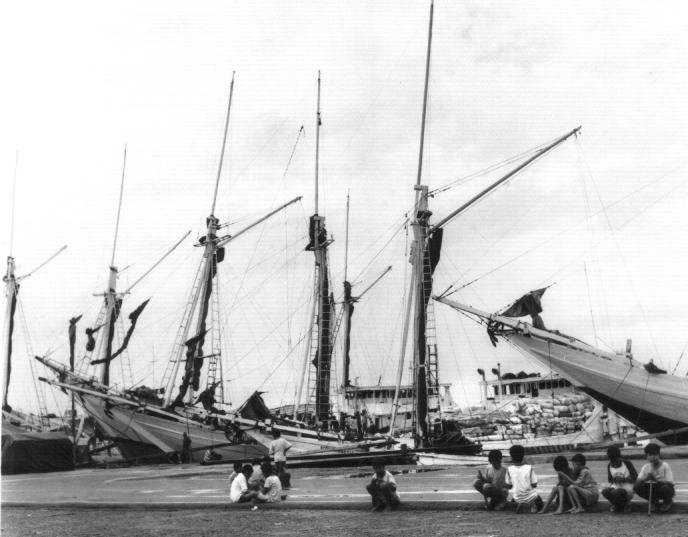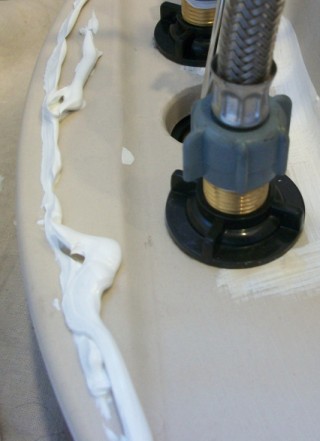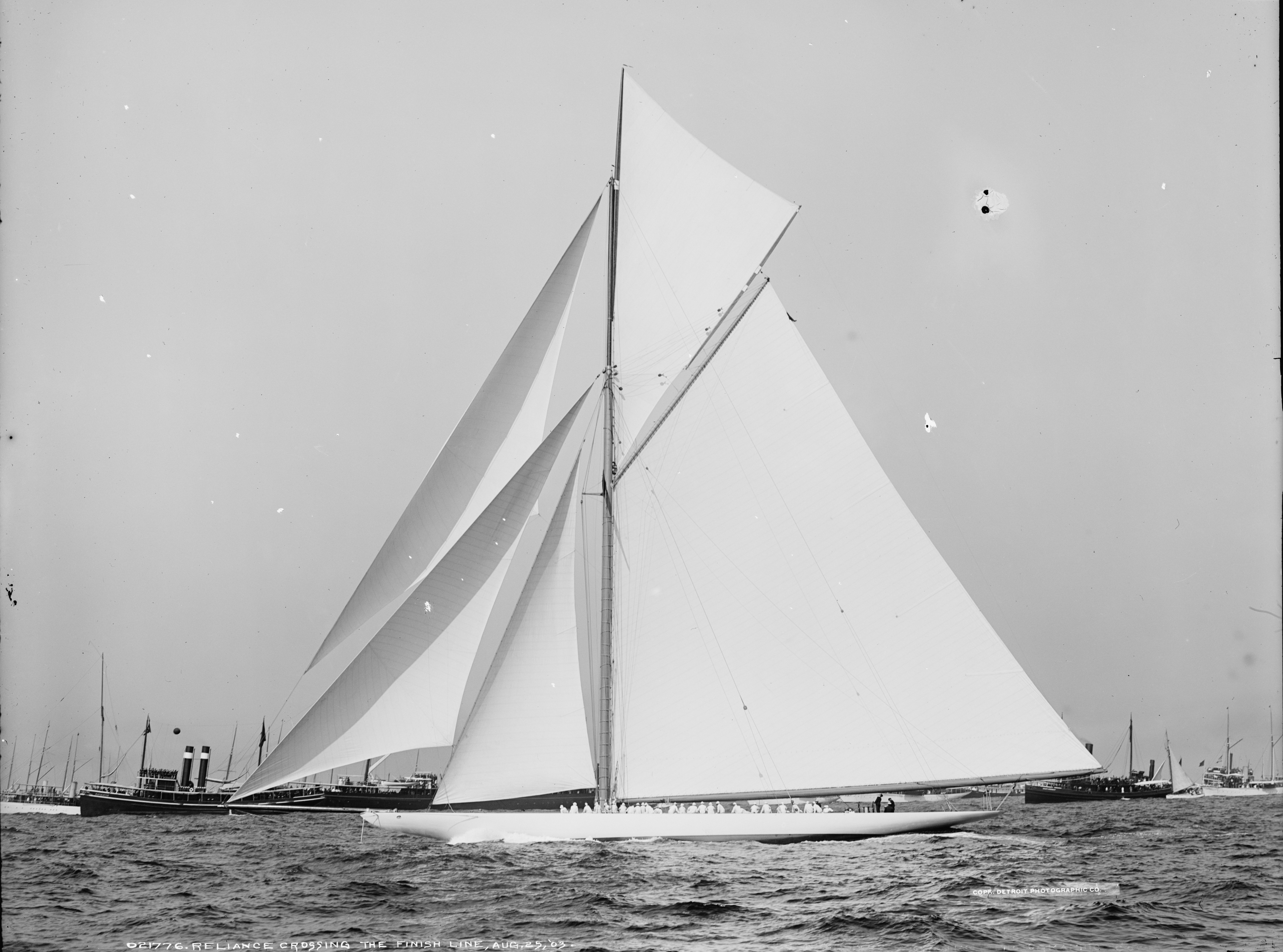|
Phinisi
Literally, the word pinisi refers to a type of rigging (the configuration of masts, sails and ropes (‘lines’)) of Indonesian sailing vessels. A pinisi carries seven to eight sails on two masts, arranged like a gaff- ketch with what is called 'standing gaffs' — i.e., unlike most Western ships using such a rig, the two main sails are not opened by raising the spars they are attached to, but the sails are 'pulled out' like curtains along the gaffs which are fixed at around the centre of the masts. As is the case with many Indonesia sailing craft, the word 'pinisi' thus names only a type of rig, and does not describe the shape of the hull of a vessel that uses such sails. Pinisi-rigged ships were mainly built by the Konjo-speaking people of Ara, a village in the district of Bontobahari, Bulukumba regency, South Sulawesi, and widely used by Buginese and Makassarese seafarers as a cargo vessel. In the years before the eventual disappearance of wind-powered transport in course ... [...More Info...] [...Related Items...] OR: [Wikipedia] [Google] [Baidu] |
Pinnace (ship's Boat)
As a ship's boat, the pinnace is a light boat, propelled by oars or sails, carried aboard merchant and war vessels in the Age of Sail to serve as a tender. The pinnace was usually rowed but could be rigged with a sail for use in favorable winds. A pinnace would ferry passengers and mail, communicate between vessels, scout to sound anchorages, convey water and provisions, or carry armed sailors for boarding expeditions. The Spanish favored them as lightweight smuggling vessels while the Dutch used them as raiders. In modern parlance, "pinnace" has come to mean an auxiliary vessel that does not fit under the " launch" or " lifeboat" definitions. Etymology The word ''pinnace'', and similar words in many languages (as far afield as Indonesia, where the boat " pinisi" took its name from the Dutch ''pinas''), came ultimately from the Spanish ''pinaza'' c. 1240, from ''pino'' ( pine tree), from the wood of which the ships were constructed. The word came into English from the Middl ... [...More Info...] [...Related Items...] OR: [Wikipedia] [Google] [Baidu] |
Bugis
The Bugis people (pronounced ), also known as Buginese, are an ethnicity—the most numerous of the three major linguistic and ethnic groups of South Sulawesi (the others being Makassar and Toraja), in the south-western province of Sulawesi, third-largest island of Indonesia. The Bugis in 1605 converted to Islam from Animism. The main religion embraced by the Bugis is Islam, with a small minority adhering to Christianity or a pre-Islamic indigenous belief called ''Tolotang''. Despite the population numbering only around six million, the Bugis are influential in the politics in modern Indonesia, and historically influential on the Malay peninsula, Sumatra, Borneo, Lesser Sunda Islands and other parts of the archipelago where they have migrated, starting in the late seventeenth century. The third president of Indonesia, B. J. Habibie, and a former vice president of Indonesia, Jusuf Kalla, are Bugis. In Malaysia, the former prime minister Muhyiddin Yassin has Bugis ancest ... [...More Info...] [...Related Items...] OR: [Wikipedia] [Google] [Baidu] |
Full-rigged Pinnace
The full-rigged pinnace was the larger of two types of vessel called a pinnace in use from the sixteenth century. Etymology The word ''pinnace'', and similar words in many languages (as far afield as Indonesia, where the boat "pinisi" took its name from the Dutch ''pinas''), came ultimately from the Spanish ''pinaza'' c. 1240, from ''pino'' (pine tree), from the wood of which the ships were constructed. The word came into English from the Middle French ''pinasse''. Design "The pinnace is perhaps the most confusing of all the early seventeenth-century types of vessels. Pinnace was more of a use than a type name, for almost any vessel could have been a pinnace or tender to a larger one. Generally speaking, pinnaces were lightly built, single-decked, square-sterned vessels suitable for exploring, trading, and light naval duties. On equal lengths, pinnaces tended to be narrower than other types. Although primarily sailing vessels, many pinnaces carried sweeps for moving in calms o ... [...More Info...] [...Related Items...] OR: [Wikipedia] [Google] [Baidu] |
Caulking
Caulk or, less frequently, caulking is a material used to seal joints or seams against leakage in various structures and piping. The oldest form of caulk consisted of fibrous materials driven into the wedge-shaped seams between boards on wooden boats or ships. Cast iron sewerage pipe were formerly caulked in a similar way. Riveted seams in ships and boilers were formerly sealed by hammering the metal. Modern caulking compounds are flexible sealing compounds used to close up gaps in buildings and other structures against water, air, dust, insects, or as a component in firestopping. In the tunnelling industry, caulking is the sealing of joints in segmental precast concrete tunnels, commonly by using concrete. Historical uses Wooden shipbuilding Traditional caulking (also spelled calking) on wooden vessels uses fibers of cotton and oakum (hemp) soaked in pine tar. These fibers are driven into the wedge-shaped seam between planks, with a caulking mallet an ... [...More Info...] [...Related Items...] OR: [Wikipedia] [Google] [Baidu] |
Gaff Rig
Gaff rig is a sailing rig (configuration of sails, mast and stays) in which the sail is four-cornered, fore-and-aft rigged, controlled at its peak and, usually, its entire head by a spar (pole) called the ''gaff''. Because of the size and shape of the sail, a gaff rig will have running backstays rather than permanent backstays. The gaff enables a fore and aft sail to be four sided, rather than triangular. A gaff rig typically carries 25 percent more sail than an equivalent Bermudian rig for a given hull design. A sail hoisted from a gaff is called a gaff-rigged (or, less commonly, gaff rigged or gaffrigged) sail. Description Gaff rig remains the most popular fore-aft rig for schooner and barquentine mainsails and other course sails, and spanker sails on a square rigged vessel are always gaff rigged. On other rigs, particularly the sloop, ketch and yawl, gaff rigged sails were once common but have now been largely replaced by the Bermuda rig sail, which, in addition ... [...More Info...] [...Related Items...] OR: [Wikipedia] [Google] [Baidu] |
Glottal Stop
The glottal plosive or stop is a type of consonantal sound used in many spoken languages, produced by obstructing airflow in the vocal tract or, more precisely, the glottis. The symbol in the International Phonetic Alphabet that represents this sound is . As a result of the obstruction of the airflow in the glottis, the glottal vibration either stops or becomes irregular with a low rate and sudden drop in intensity. Features Features of the glottal stop: * It has no phonation, as there is no airflow through the glottis. It is voiceless, however, in the sense that it is produced without vibration of the vocal cords. Writing In the traditional Romanization of many languages, such as Arabic, the glottal stop is transcribed with the apostrophe or the symbol ʾ, which is the source of the IPA character . In many Polynesian languages that use the Latin alphabet, however, the glottal stop is written with a rotated apostrophe, (called '' ‘okina'' in Hawaiian and S ... [...More Info...] [...Related Items...] OR: [Wikipedia] [Google] [Baidu] |
Coastal Konjo Language
Coastal Konjo is an Austronesian language of Sulawesi, Indonesia, which belongs to the Makassaric branch of the South Sulawesi subgroup. It is spoken along the coast in the southeastern corner of South Sulawesi in the regencies of Sinjai, Bulukumba and Bantaeng. It is closely related to, but distinct from Highland Konjo, which also belongs to the Makassaric languages The Makassaric languages are a group of languages spoken in the southern part of South Sulawesi province, Indonesia, and make up one of the branches of the South Sulawesi subgroup in the Austronesian language family. The most prominent member o .... Phonology The following sound inventory is based on Friberg & Friberg (1991). The vowel is realized as before geminate nasals. Only and can appear in final position. Words with underlying final , or add an echo vowel, e.g. /nipis/ nipisi'thin'. Grammar Personal pronouns in Coastal Konjo have one independent form, and three bound forms. Reference ... [...More Info...] [...Related Items...] OR: [Wikipedia] [Google] [Baidu] |
Piracy
Piracy is an act of robbery or criminal violence by ship or boat-borne attackers upon another ship or a coastal area, typically with the goal of stealing cargo and other valuable goods. Those who conduct acts of piracy are called pirates, vessels used for piracy are pirate ships. The earliest documented instances of piracy were in the 14th century BC, when the Sea Peoples, a group of ocean raiders, attacked the ships of the Aegean and Mediterranean civilisations. Narrow channels which funnel shipping into predictable routes have long created opportunities for piracy, as well as for privateering and commerce raiding. Historic examples include the waters of Gibraltar, the Strait of Malacca, Madagascar, the Gulf of Aden, and the English Channel, whose geographic structures facilitated pirate attacks. The term ''piracy'' generally refers to maritime piracy, although the term has been generalized to refer to acts committed on land, in the air, on computer networks, and (in s ... [...More Info...] [...Related Items...] OR: [Wikipedia] [Google] [Baidu] |
Sultan Of Terengganu
Sultan of Terengganu () is the title of the constitutional head of Terengganu state in Malaysia. The current Sultan Mizan Zainal Abidin of Terengganu, is the 18th sultan and 13th Yang di-Pertuan Agong of Malaysia from 2006 to 2011. He is the head of the religion of Islam in the state and the source of all titles, honours and dignities in the state. History Terengganu emerged as an independent sultanate in 1725. The first sultan was Zainal Abidin I, the younger brother of a former sultan of Johor, and Johor strongly influenced Terengganu politics through the 18th century. However, in the book '' Tuhfat al-Nafis'', the author, Raja Ali Haji, mentions that in the year 1708, Zainal Abidin I was installed as the Sultan of Terengganu by Daeng Menampuk – also known as Raja Tua – under the rule of Sultan Sulaiman Badrul Alam Shah. In the 19th century, Terengganu became a vassal state of the Thai Rattanakosin Kingdom, and sent tribute every year called '' bunga mas''. This occurr ... [...More Info...] [...Related Items...] OR: [Wikipedia] [Google] [Baidu] |




